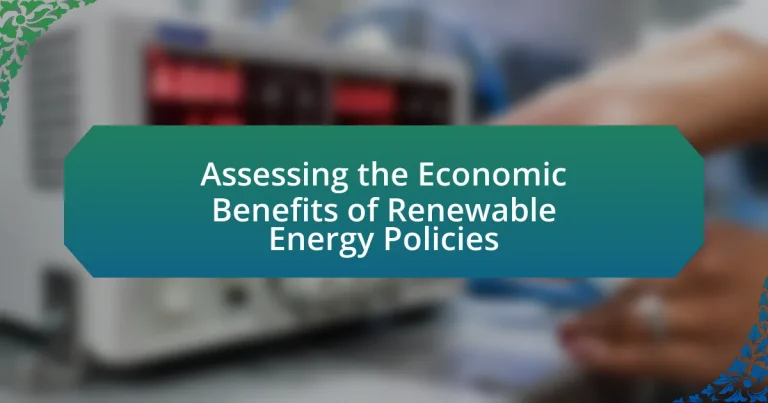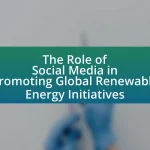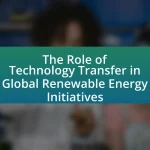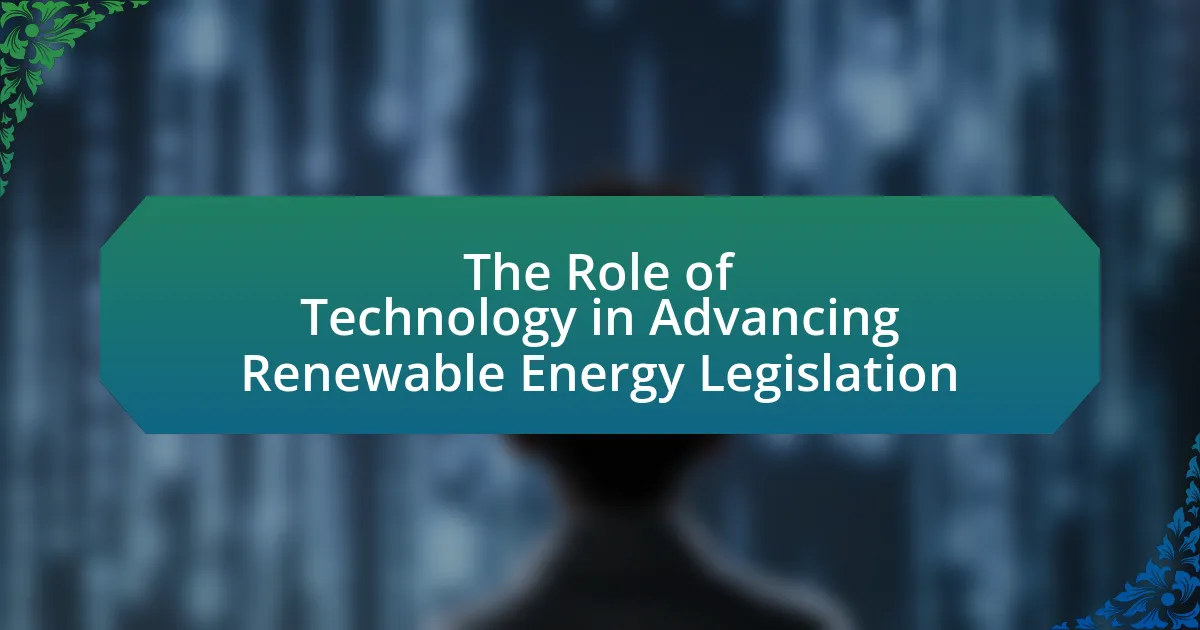Renewable energy policies are regulations and incentives aimed at promoting the use of renewable energy sources such as solar, wind, and hydroelectric power. These policies have significant economic implications, including job creation, reduced energy costs, and increased energy independence. The article explores how these policies influence economic growth, the key components that drive their effectiveness, and the metrics used to assess their economic benefits. Additionally, it addresses the challenges in evaluating these benefits and offers strategies for maximizing the economic returns of renewable energy initiatives.
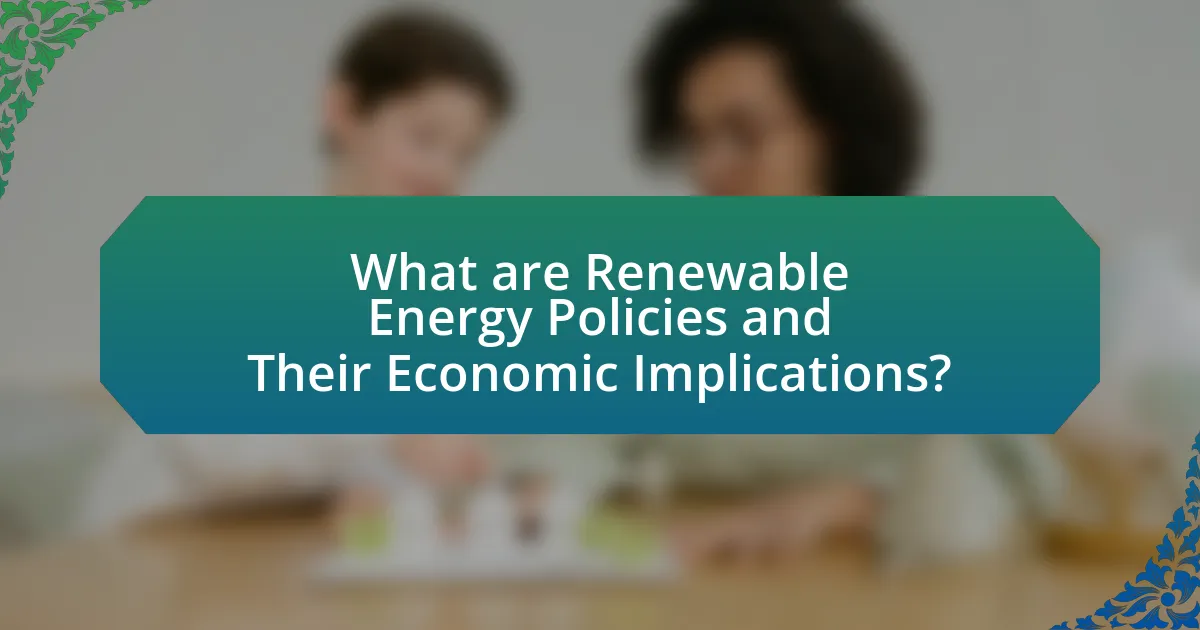
What are Renewable Energy Policies and Their Economic Implications?
Renewable energy policies are regulations and incentives designed to promote the development and use of renewable energy sources such as solar, wind, and hydroelectric power. These policies aim to reduce greenhouse gas emissions, enhance energy security, and stimulate economic growth. Economic implications of these policies include job creation in the renewable energy sector, which has been shown to employ over 3 million people in the United States alone as of 2021, according to the U.S. Department of Energy. Additionally, renewable energy policies can lead to lower energy costs over time, as the cost of renewable technologies continues to decline, with solar photovoltaic costs dropping by 89% since 2009. Furthermore, these policies can attract investments, with global renewable energy investments reaching $303.5 billion in 2020, highlighting their potential to drive economic development.
How do Renewable Energy Policies influence economic growth?
Renewable energy policies significantly influence economic growth by promoting investment in clean energy technologies, which creates jobs and stimulates local economies. For instance, the International Renewable Energy Agency reported that the renewable energy sector employed over 11 million people globally in 2018, demonstrating the job creation potential of these policies. Additionally, countries that implement strong renewable energy policies often experience increased energy independence, reducing reliance on imported fossil fuels and enhancing economic stability. A study by the World Bank found that countries investing in renewable energy can achieve higher GDP growth rates, as these investments lead to innovation and technological advancements. Thus, renewable energy policies not only foster job creation but also contribute to sustainable economic development.
What are the key components of Renewable Energy Policies?
The key components of Renewable Energy Policies include regulatory frameworks, financial incentives, technology support, and market mechanisms. Regulatory frameworks establish the legal and institutional structures necessary for renewable energy development, ensuring compliance and promoting investment. Financial incentives, such as tax credits and subsidies, encourage the adoption of renewable technologies by reducing initial costs. Technology support focuses on research and development to enhance efficiency and reduce costs of renewable energy systems. Market mechanisms, including renewable energy certificates and feed-in tariffs, create economic incentives for energy producers to invest in renewable sources. These components collectively drive the transition to sustainable energy systems and contribute to economic growth, as evidenced by the International Renewable Energy Agency’s report, which highlights that renewable energy policies can lead to job creation and increased energy security.
How do these policies impact job creation in the renewable sector?
Renewable energy policies significantly enhance job creation in the renewable sector by incentivizing investment and development in clean energy technologies. For instance, the International Renewable Energy Agency reported that global renewable energy employment reached 11.5 million jobs in 2018, driven by supportive policies such as tax credits and subsidies. These policies stimulate demand for renewable energy projects, leading to increased hiring in manufacturing, installation, and maintenance roles. Additionally, a study by the U.S. Department of Energy found that every megawatt of solar energy installed creates approximately 5.65 jobs, illustrating the direct correlation between policy support and job growth in the sector.
Why is it important to assess the economic benefits of these policies?
Assessing the economic benefits of renewable energy policies is crucial because it enables policymakers to understand the financial impacts and returns on investment associated with these initiatives. By evaluating metrics such as job creation, energy cost savings, and environmental benefits, stakeholders can make informed decisions that promote sustainable economic growth. For instance, a study by the International Renewable Energy Agency (IRENA) found that the renewable energy sector employed over 11 million people globally in 2018, highlighting the job creation potential of these policies. This assessment not only supports the justification of funding and resources but also helps in optimizing policy frameworks to maximize economic advantages.
What metrics are used to evaluate economic benefits?
Metrics used to evaluate economic benefits include cost-benefit analysis, return on investment (ROI), net present value (NPV), and economic impact assessments. Cost-benefit analysis quantifies the total expected costs against the total expected benefits, providing a clear financial picture. ROI measures the profitability of an investment relative to its cost, while NPV calculates the difference between the present value of cash inflows and outflows over time, indicating the profitability of an investment. Economic impact assessments evaluate the broader effects of policies on employment, income, and economic growth, often using input-output models to quantify these impacts. These metrics are essential for determining the effectiveness and efficiency of renewable energy policies in delivering economic benefits.
How do these assessments affect policy-making decisions?
Assessments of the economic benefits of renewable energy policies significantly influence policy-making decisions by providing data-driven insights that guide resource allocation and regulatory frameworks. These assessments quantify potential job creation, cost savings, and environmental impacts, enabling policymakers to make informed choices that align with economic and sustainability goals. For instance, a study by the International Renewable Energy Agency (IRENA) found that transitioning to renewable energy could create 24 million jobs globally by 2030, illustrating the tangible benefits that assessments can highlight. Such concrete evidence supports the development of policies that promote renewable energy investments, ultimately shaping a more sustainable economic landscape.
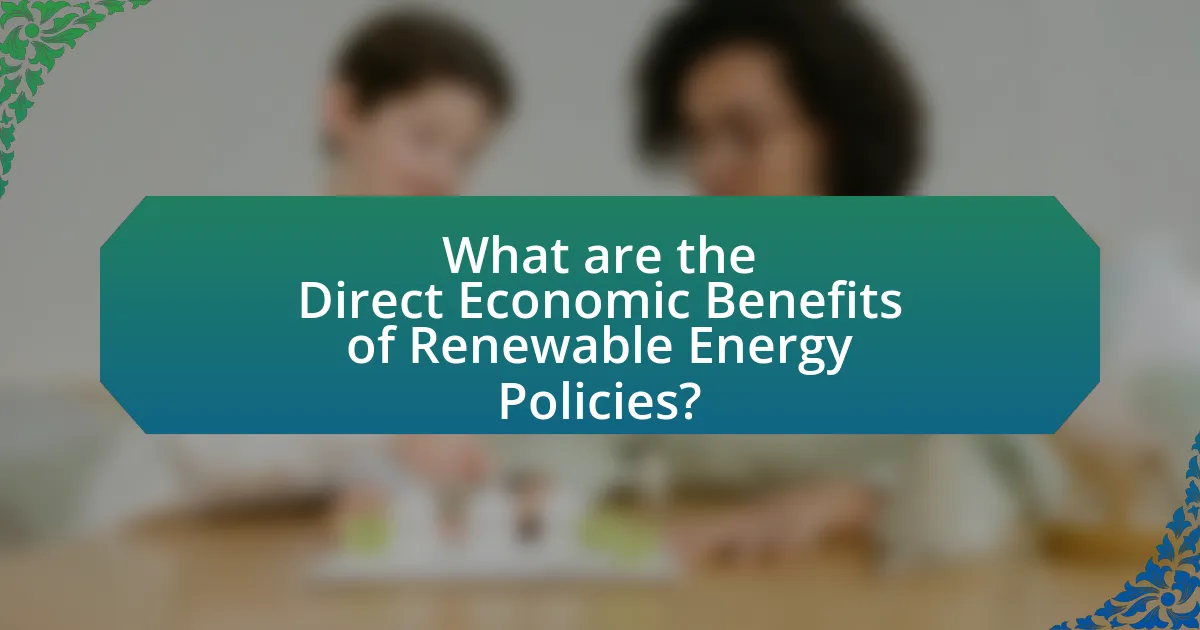
What are the Direct Economic Benefits of Renewable Energy Policies?
The direct economic benefits of renewable energy policies include job creation, reduced energy costs, and increased energy independence. Job creation is significant; for instance, the U.S. solar industry employed over 250,000 workers in 2019, reflecting a growth rate of 167% since 2010. Reduced energy costs arise from the declining prices of renewable technologies, with the cost of solar energy dropping by 89% since 2009, making it increasingly competitive with fossil fuels. Increased energy independence is achieved as countries invest in domestic renewable resources, reducing reliance on imported fuels, which can enhance national security and stabilize local economies. These benefits collectively contribute to a more sustainable and resilient economic framework.
How do Renewable Energy Policies reduce energy costs?
Renewable energy policies reduce energy costs by promoting the development and integration of renewable energy sources, which often have lower operational costs compared to fossil fuels. For instance, the levelized cost of electricity (LCOE) for solar and wind energy has decreased significantly, with solar energy costs dropping by approximately 89% since 2009, according to the International Renewable Energy Agency (IRENA). This reduction in costs is driven by technological advancements, economies of scale, and increased competition in the energy market. Additionally, renewable energy policies often include incentives such as tax credits and subsidies, which further lower the financial barriers for consumers and businesses, leading to overall reduced energy expenses.
What role do subsidies play in lowering energy prices?
Subsidies play a crucial role in lowering energy prices by reducing the overall cost of energy production and encouraging investment in renewable energy sources. By providing financial support to energy producers, subsidies can lower the price at which energy is sold to consumers. For instance, in the United States, the federal Investment Tax Credit (ITC) has significantly reduced the cost of solar energy systems, leading to a 70% decrease in the price of solar energy from 2010 to 2020. This reduction in production costs translates to lower prices for consumers, making renewable energy more competitive with fossil fuels. Additionally, subsidies can stimulate market competition, further driving down prices as more renewable energy projects come online.
How does increased competition in energy markets affect prices?
Increased competition in energy markets typically leads to lower prices for consumers. When multiple suppliers enter the market, they strive to attract customers by offering more competitive pricing, which drives down overall energy costs. For instance, a study by the International Energy Agency found that liberalized energy markets, characterized by increased competition, resulted in price reductions of up to 30% in some regions. This competitive environment encourages innovation and efficiency among energy providers, further contributing to price decreases.
What are the environmental economic benefits associated with these policies?
The environmental economic benefits associated with renewable energy policies include reduced greenhouse gas emissions, improved public health, and job creation in the green sector. These policies lead to a transition from fossil fuels to renewable sources, which significantly lowers carbon dioxide emissions; for instance, the International Renewable Energy Agency reported that renewable energy could reduce global CO2 emissions by up to 70% by 2050. Additionally, cleaner air resulting from decreased fossil fuel use leads to lower healthcare costs, as air pollution is linked to respiratory diseases. Furthermore, the renewable energy sector has been shown to create more jobs per unit of electricity generated compared to fossil fuels; a report by the U.S. Bureau of Labor Statistics indicated that jobs in solar and wind energy are among the fastest-growing in the country.
How do Renewable Energy Policies contribute to reducing carbon emissions?
Renewable energy policies significantly contribute to reducing carbon emissions by promoting the use of clean energy sources such as wind, solar, and hydroelectric power. These policies incentivize the transition from fossil fuels, which are major contributors to greenhouse gas emissions, to renewable energy technologies that produce little to no emissions during operation. For instance, according to the International Renewable Energy Agency, the global shift to renewable energy could reduce carbon dioxide emissions by up to 70% by 2050. Additionally, policies such as tax credits, subsidies, and renewable portfolio standards encourage investment in renewable energy infrastructure, further decreasing reliance on carbon-intensive energy sources.
What are the long-term economic savings from environmental protection?
Long-term economic savings from environmental protection include reduced healthcare costs, increased energy efficiency, and enhanced ecosystem services. For instance, the American Public Health Association estimates that air pollution control measures can save the U.S. economy approximately $2 trillion by 2020 through decreased healthcare expenses related to respiratory diseases. Additionally, investments in renewable energy can lead to lower energy costs over time; the International Renewable Energy Agency reported that solar and wind energy costs have dropped by 80% and 49%, respectively, since 2010, resulting in significant savings for consumers and businesses. Furthermore, protecting ecosystems can provide services valued at trillions of dollars, such as clean water and pollination, which contribute to agricultural productivity and overall economic stability.
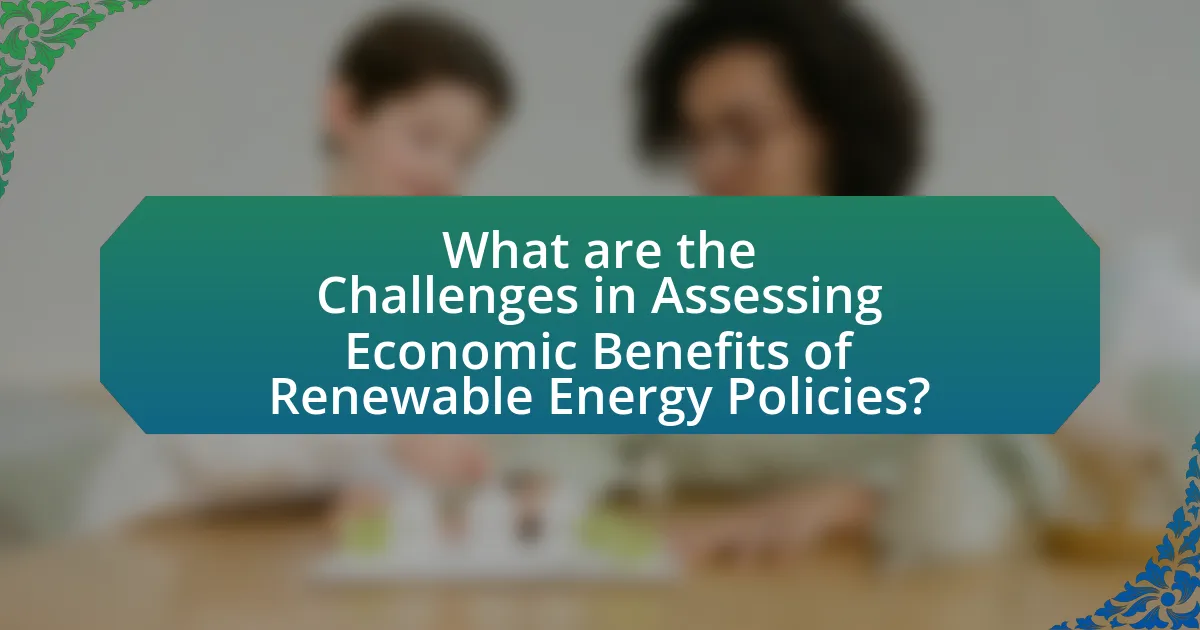
What are the Challenges in Assessing Economic Benefits of Renewable Energy Policies?
The challenges in assessing the economic benefits of renewable energy policies include quantifying indirect benefits, accounting for long-term impacts, and dealing with data limitations. Quantifying indirect benefits, such as job creation and health improvements, is complex due to the difficulty in establishing direct causation. Long-term impacts, like environmental sustainability and energy security, are often not immediately measurable, complicating assessments. Additionally, data limitations arise from inconsistent reporting standards and the variability of renewable energy sources, making it hard to compare economic outcomes across different regions and policies. These factors collectively hinder accurate evaluations of the economic benefits associated with renewable energy initiatives.
What are the common obstacles in measuring economic impacts?
Common obstacles in measuring economic impacts include data availability, methodological challenges, and attribution issues. Data availability is often limited, as comprehensive datasets may not exist or may be difficult to access, hindering accurate assessments. Methodological challenges arise from the complexity of economic systems, where isolating the effects of specific policies can be difficult due to numerous influencing factors. Attribution issues complicate the measurement process, as determining the direct impact of renewable energy policies versus other economic variables can lead to ambiguous results. These obstacles collectively impede the accurate evaluation of economic impacts associated with renewable energy initiatives.
How do data limitations affect the assessment process?
Data limitations significantly hinder the assessment process by restricting the availability and quality of information necessary for accurate evaluations. In the context of assessing the economic benefits of renewable energy policies, insufficient data can lead to incomplete analyses, resulting in misguided policy recommendations. For instance, a lack of comprehensive data on energy production costs or environmental impacts can skew cost-benefit analyses, making it difficult to determine the true economic viability of renewable energy initiatives. Studies have shown that regions with robust data collection frameworks yield more reliable assessments, highlighting the critical role of data integrity in informing effective energy policies.
What biases can influence the evaluation of economic benefits?
Cognitive biases such as confirmation bias, anchoring bias, and availability heuristic can significantly influence the evaluation of economic benefits. Confirmation bias leads evaluators to favor information that supports their pre-existing beliefs about renewable energy policies, potentially overlooking contrary evidence. Anchoring bias occurs when initial estimates or figures unduly influence subsequent evaluations, causing skewed assessments of economic benefits. The availability heuristic can result in overestimating the importance of recent or vivid examples of economic benefits, while neglecting broader data trends. These biases can distort the objective analysis required for accurate assessments of renewable energy policies’ economic impacts.
How can policymakers overcome these challenges?
Policymakers can overcome challenges in assessing the economic benefits of renewable energy policies by implementing comprehensive data collection and analysis frameworks. These frameworks should focus on quantifying the direct and indirect economic impacts of renewable energy investments, such as job creation, energy savings, and environmental benefits. For instance, a study by the International Renewable Energy Agency (IRENA) found that renewable energy sectors created 11.5 million jobs globally in 2018, demonstrating significant employment potential. Additionally, policymakers can foster collaboration between government agencies, private sectors, and academic institutions to enhance research and share best practices. This collaborative approach can lead to more informed decision-making and effective policy design, ultimately maximizing the economic benefits of renewable energy initiatives.
What best practices can enhance the accuracy of economic assessments?
To enhance the accuracy of economic assessments, employing robust data collection methods is essential. Accurate economic assessments rely on high-quality, relevant data that reflects current market conditions and trends. Utilizing diverse data sources, such as government reports, academic studies, and industry analyses, ensures a comprehensive understanding of the economic landscape. Additionally, applying advanced statistical techniques, like regression analysis and econometric modeling, can improve the reliability of the findings. For instance, a study by the International Renewable Energy Agency (IRENA) highlights that incorporating multiple scenarios and sensitivity analyses can significantly refine economic forecasts related to renewable energy investments. This approach allows for a more nuanced understanding of potential outcomes, thereby enhancing the overall accuracy of economic assessments.
How can stakeholder engagement improve the evaluation process?
Stakeholder engagement can significantly enhance the evaluation process by incorporating diverse perspectives and expertise, leading to more comprehensive assessments. Engaging stakeholders, such as community members, industry experts, and policymakers, ensures that the evaluation captures a wide range of insights and concerns, which can improve the relevance and accuracy of the findings. For instance, studies have shown that involving stakeholders in the evaluation of renewable energy policies can lead to better identification of economic impacts and social acceptance, as evidenced by the research conducted by the International Renewable Energy Agency, which highlights that stakeholder involvement often results in more effective policy implementation and greater public support.
What are the best strategies for maximizing the economic benefits of Renewable Energy Policies?
The best strategies for maximizing the economic benefits of Renewable Energy Policies include implementing feed-in tariffs, investing in grid infrastructure, and promoting public-private partnerships. Feed-in tariffs guarantee fixed payments for renewable energy producers, which incentivizes investment and stabilizes revenue streams. For instance, Germany’s feed-in tariff system has significantly increased solar energy capacity, leading to job creation and economic growth. Investing in grid infrastructure enhances the integration of renewable sources, reducing transmission losses and improving reliability, as seen in California’s investments that have facilitated a higher share of renewables in the energy mix. Public-private partnerships leverage private sector efficiency and innovation, exemplified by the collaboration between the U.S. Department of Energy and private companies in advancing solar technology, which has driven down costs and increased deployment. These strategies collectively enhance economic returns while fostering sustainable energy development.
